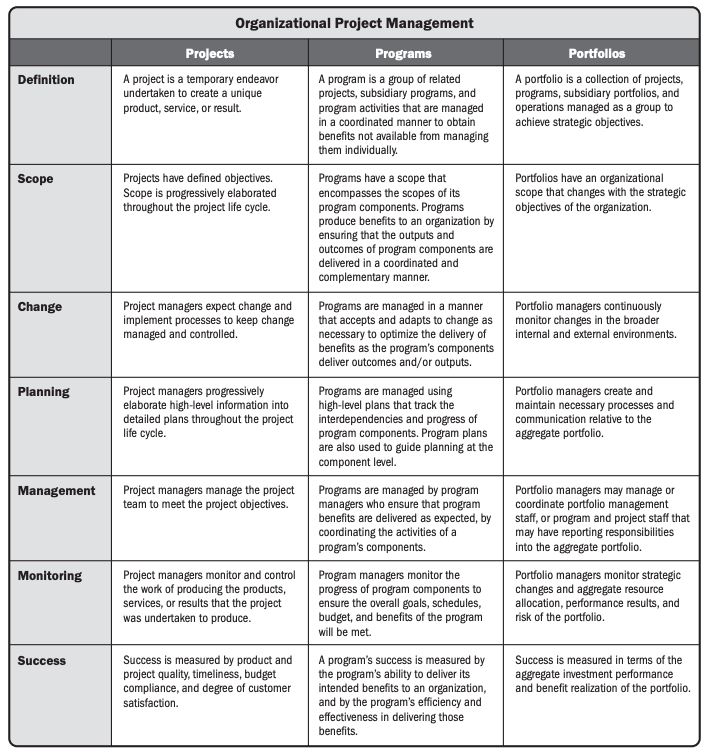Project vs Program vs Portfolio: Key Differences
Introduction
Understanding the difference between a project, program, and portfolio is fundamental for effective project management. Whether you’re preparing for the PMP®, PgMP®, or PfMP® certification, grasping how each layer contributes to strategic value delivery will elevate your ability to lead and align initiatives across an organization. In this post, we break down the distinctions and real-world applications of project vs program vs portfolio.
Imagine a seasoned project manager working at a global telecom company. She’s successfully delivered dozens of projects on time and under budget. But when asked to oversee a program, she’s suddenly overwhelmed. Why? Because managing multiple, interconnected projects with shared risks and benefits is a different game entirely.
Now imagine a portfolio manager at the same company deciding which programs to fund based on business strategy, ROI, and risk appetite. These roles differ significantly—but are deeply connected.
What Is a Project?
A project is a temporary endeavor undertaken to create a unique product, service, or result. Projects have:
- A clear start and end date
- Defined objectives and deliverables
- Specific constraints (scope, time, cost, etc.)
Example: Developing a mobile banking app with set features, a six-month timeline, and a fixed budget.
Projects focus on doing things right—on-time, on-budget, with the agreed scope.
👉 Learn more in our foundational blog post on Definition and Objectives.
👉 Also see Project Constraints: Scope, Time, Cost, Quality, Resources, Risk
What Is a Program?
A program is a group of related projects managed in a coordinated manner to obtain benefits not available from managing them individually.
Programs focus on synergy—combining efforts to create more value.
Example: A “Digital Customer Experience” program could include:
- A project to redesign the website
- A mobile app project
- A CRM upgrade project
- A training project for customer service agents
These projects share stakeholders, risks, resources, and strategic objectives. The program manager oversees dependencies, resolves conflicts, and ensures that collective outcomes align with business goals.
Key Responsibilities of Program Managers:
- Benefit realization
- Stakeholder alignment
- Risk and change coordination across projects
- Continuous optimization
What Is a Portfolio?
A portfolio is a collection of projects, programs, and other work grouped together to facilitate effective governance and meet strategic business objectives.
Example: An enterprise-wide “Innovation Portfolio” could include:
- The “Digital Customer Experience” program
- A standalone project on AI R&D
- An initiative to evaluate new markets
Portfolios are not always interdependent. Their main purpose is investment decision-making based on value, risk, and alignment with strategic goals.
Portfolio Managers:
- Prioritize programs and projects
- Balance resource allocation across initiatives
- Track performance at the strategic level
- Adjust or terminate initiatives based on evolving business needs
Explore the PMI framework on Organizational Project Management (OPM)
Also see Harvard Business Review – Strategic Portfolio Planning
Projects vs Programs vs Portfolios – A Comparative Table

| Element | Project | Program | Portfolio |
|---|---|---|---|
| Purpose | Deliver a specific output | Achieve outcomes via related projects | Achieve strategic objectives |
| Scope | Defined and narrow | Broad with interdependencies | Broad and strategic |
| Success Criteria | On-time, on-budget, within scope | Benefits realization | Strategic value and ROI |
| Manager Role | Project Manager | Program Manager | Portfolio Manager |
| Focus | Outputs | Outcomes | Strategic alignment and investment |
| Timeframe | Temporary | Longer-term than a single project | Ongoing or long-term |
Why It Matters for Project Professionals
1. Clarity in Your Role
Knowing where you fit in the hierarchy helps you better manage expectations and contribute to value delivery.
2. Career Progression
Understanding the difference sets you up to grow from project manager to program or portfolio manager. Certifications like PgMP® and PfMP® require a solid grasp of these distinctions.
3. Strategic Thinking
Projects don’t exist in a vacuum. Recognizing the broader organizational context allows you to:
- Prioritize deliverables that align with strategic objectives.
- Communicate more effectively with executives and stakeholders.
- Avoid local optimization at the cost of strategic misalignment.
4. Improved Resource Management
By understanding programs and portfolios, you can coordinate better with other teams and use organizational resources more wisely.
Real-World Lessons from Senior PMs
Case Insight – Telecom Industry
“We once had two separate projects: one on improving customer billing and another for launching a chatbot. Managed independently, they caused confusion. When we realized both supported the same digital transformation strategy, we grouped them into a program. That move saved us time, reduced duplication, and improved the customer journey.”
— Sanjay K., Program Manager (PgMP®)
Case Insight – Government Portfolio Office
“As a portfolio manager in the public sector, I don’t just look at project schedules. I evaluate initiatives based on their potential to deliver social impact, fit with policy objectives, and risk exposure. Sometimes that means saying no to a perfectly scoped project if it doesn’t serve the greater strategic vision.”
— Linda T., PfMP®
Final Thoughts
Understanding the differences between projects, programs, and portfolios is a critical skill that separates tactical project managers from strategic leaders. Whether you’re managing a single sprint or evaluating dozens of initiatives, knowing where your work fits in the big picture is key to delivering lasting impact.
In the next post, we’ll explore Organizational Alignment — how strategy connects to execution, and how portfolio, program, and project leaders ensure consistent delivery of value.
Topics You can explore:
- Definition and Objectives of a Project
- Project Constraints: Scope, Time, Cost, Quality…
- The Iron Triangle and Trade-Offs
- Organizational Alignmentfor Strategy Execution
Tag:benefits realization management, enterprise project planning, how to align projects with business goals, organizational project management, PgMP vs PMP vs PfMP, PMI program management framework, PMP certification program alignment, portfolio management strategy, program management in real life, project governance best practices, project hierarchy explained, project vs program vs portfolio, strategic alignment in project management
